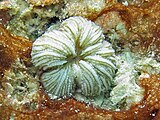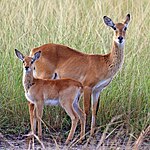User talk:Maias/Archive 11
| This is an archive of past discussions about User:Maias. Do not edit the contents of this page. If you wish to start a new discussion or revive an old one, please do so on the current talk page. |
| Archive 5 | ← | Archive 9 | Archive 10 | Archive 11 | Archive 12 | Archive 13 | → | Archive 15 |
Tree of Life Newsletter

- July 2019—Issue 004
- Tree of Life
- Welcome to the Tree of Life newsletter!
|
|
|
|
|
The WikiCup, an annual editing competition, is now in its fourth round. Casliber, consistent participant since 2010 and winner in 2016, is currently dominating Group A with 601 points. Largely responsible is the successful Featured Article nomination of Masked booby. The other remaining Tree of Life participant, Enwebb, is participating in her first ever WikiCup. In this round, she has a grand total of...5 points. But with the recent Featured Article nomination of Megabat, she stands to gain 600 points if successful. As it stands, though, it appears that at least one ToL editor is headed to the fifth and final round of 8 contestants, which begins September 1. Thus far, all participants in the WikiCup have generated 17 Featured Articles, 116 Good Articles, 16 Featured Lists, and 57 Featured Pictures. The Good Article Nominations backlog has been reduced as well, with 286 Good Article Reviews. |
|
For this month's editor spotlight we're joined by Charlesjsharp, a longtime contributor to Wikimedia Commons with a plethora of featured pictures on English Wikipedia. 1) Starsandwhales: How long have you been editing Wikipedia, and how did you get interested? How did you begin your journey of photographing wildlife?
 2) S&W: Over the years, you've taken photos of many different organisms from birds to insects to big cats; you have an extensive list of favorite images. Which animals have been the most exciting for you to photograph?
3) S&W: Many articles under ToL have requests for people to add images that can go unanswered. What can the community do to improve the coverage of different organisms on Wikipedia, especially when it comes to images?

4) S&W: What advice would you give to people new to photographing wildlife?
5) S&W: What would the Tree of Life community be surprised to learn about your life off-wiki?
* An example of cumbersome code: getting the layout of my responses to your questions. So dated, and no online spellchecker. |
|
You are receiving this because you added your name to the subscribers list of the WikiProject Tree of Life. If you no longer wish to receive the newsletter, please remove your name.
Sent by ZLEA via MediaWiki message delivery (talk) 18:59, 1 August 2019 (UTC)
Crotalaria cunninghamii
In Crotalaria cunninghamii (a page you started) you stated from the very beginning "It is pollinated by large bees and by honeyeaters." I have now looked at the references you put forward at the time but was unable to find anything justifying the statement. I am hoping you can find where you found it and insert the appropriate citation. MargaretRDonald (talk) 11:32, 4 August 2019 (UTC)
- Hi Margaret. Sorry, I am afraid I cannot really help you with this as I do not remember. I can only assume that I found the information in one of the website references at the time, from which it has since been removed. In the absence of current corroboration, it would be best to delete it. Cheers. Maias (talk) 13:16, 4 August 2019 (UTC)
August 2019 Tree of Life Newsletter

- August 2019—Issue 005
- Tree of Life
- Welcome to the Tree of Life newsletter!
|
|
|
|
  Guest column by Thomas Shafee (Evolution and evolvability), Editor in Chief of WikiJournal of Science
Firstly, WikiJSci can be a complementary system for FA review (getting external review, input, and validity). When an Wikipedia article is nominated (via WP:JAN), journal editors go out to non-Wikipedian academics and researchers who have published on the subject on the last five years and invite them to give feedback comments (e.g. Peripatric speciation and Baryonyx). The resulting changes can then be integrated back into the Wikipedia article.
Getting more editors involved in Wikipedia is always a high priority. WikiJSci can also be a way to encourage new people to contribute articles (especially on missing/stub/start topics). An example of an article that was written from scratch by a group of non-Wikipedians is Teladorsagia circumcincta. This not only resulted in a new Wikipedia page on an underdeveloped topic, but introduced the idea of Wikimedia contribution to a group of people who had previously never considered it.
The journal can be a way to get multimedia content reviewed or encourage contribution. The same approach could be easily adapted to sounds (e.g. frog mating calls) or videos (e.g. starfish feet motion). It also allows for tracking of those images in new articles via Altmetric (this example has >200, which is bananas). There aren't any biology examples in WikiJSci yet, but the sister medical journal has published a few summary diagrams, photography, and image galleries. Examples include this gallery by Blausen Medical or the diagram of cell disassembly during apoptosis.
For those interested in other Wikimedia sister projects, there's also broad scope for interactions with the WikiJournals. Perhaps peer reviewed teaching resources could be useful to sit alongside sets of Wikipedia articles and be integrated into Wikiversity courses (like this or this)? Can sections of Wikidata & Wikispecies be peer reviewed? What are the potential avenues for integration with WikiCite, WikiFactMine, Scholia, etc.? Currently, WikiJSci is aiming to be very flexible and try out different formats so long as they can be externally peer reviewed. For more info, see the 2019-06-30 Signpost article and the current sister project proposal. |
|
1) Enwebb: You're very prolific with DYKs, with over 2,000 nominations credited (in fact, I'll highlight which DYK nominations this month were yours below). What made you become so involved in this part of Wikipedia? Why should Tree of Life editors nominate articles for DYK?
2) Enwebb: I noticed that your DYK nominations reflect a diverse array of flora and fauna, from trees, marine invertebrates, birds, fishes, and mammals. How do you decide what to work on?
3) Enwebb: Which of your Wikipedia accomplishments are you most proud of?
4) Enwebb: What motivates you to keep contributing? What's your 10,000 ft view (pardon the non-SI) of the community and Tree of Life?
6) Enwebb: How did you first become interested in natural history?
|
|
You are receiving this because you added your name to the subscribers list of the WikiProject Tree of Life. If you no longer wish to receive the newsletter, please remove your name.
Sent by ZLEA via MediaWiki message delivery (talk) at 15:43, 1 September 2019 (UTC)
September 2019 GOCE Newsletter
Guild of Copy Editors September 2019 Newsletter
  Hello and welcome to the September newsletter, a brief update of Guild activities since June 2019. June election: Reidgreg was chosen as lead coordinator, and is being assisted by Baffle gab1978, Miniapolis, Tdslk, and first-time coordinator Twofingered Typist. Jonesey95 took a respite after serving for six years. Thanks to everyone who participated! June Blitz: From 16 to 22 June, we copy edited articles on the themes of nature and the environment along with requests. 12 participating editors completed 35 copy edits. Final results, including barnstars awarded, are available here. July Drive: The year's fourth backlog-elimination drive was a great success, clearing all articles tagged in January and February, and bringing the copy-editing backlog to a low of five months and a record low of 585 articles while also completing 48 requests. Of the 30 people who signed up, 29 copyedited at least one article, a participation level last matched in May 2015. Final results and awards are listed here. August Blitz: From 18 to 24 August, we copy edited articles tagged in March 2019 and requests. 12 participating editors completed 26 copy edits on the blitz. Final results, including barnstars awarded, are available here. Progress report: As of 03:00, 23 September 2019 (UTC), GOCE copyeditors had processed 413 requests since 1 January. The backlog of tagged articles stood at 599 articles, close to our record month-end low of 585. Requests page: We are experimenting with automated archiving of copy edit requests; a discussion on REQ Talk (permalinked) initiated by Bobbychan193 has resulted in Zhuyifei1999 writing a bot script for the Guild. Testing is now underway and is expected to be completed by 3 October; for this reason, no manual archiving of requests should be done until the testing period is over. We will then assess the bot's performance and discuss whether to make this arrangement permanent. September Drive: Our current backlog-elimination drive is open until 23:59 on 30 September (UTC) and is open to all copy editors. Sign up today! Thank you all again for your participation; we wouldn't be able to achieve what we have without you! Cheers from your GOCE coordinators, Baffle gab1978, Miniapolis, Reidgreg, Tdslk and Twofingered Typist. To discontinue receiving GOCE newsletters, please remove your name from our mailing list.
|
MediaWiki message delivery (talk) 03:58, 24 September 2019 (UTC)
Books & Bytes – Issue 35, July – August 2019
Books & Bytes
Issue 35, July – August 2019
- Wikimania
- We're building something great, but..
- Wikimedia and Libraries User Group update
- A Wikibrarian's story
- Bytes in brief
On behalf of The Wikipedia Library team --MediaWiki message delivery (talk) 06:58, 27 September 2019 (UTC)
September 2019 Tree of Life Newsletter

- September 2019—Issue 006
- Tree of Life
- Welcome to the Tree of Life newsletter!
|
|
|
|
|
|
5
10
15
20
'02
'04
'06
'08
'10
'12
'14
'16
'18
Tree of Life subprojects and task forces by start year and whether currently considered active or not This month saw a vanishingly rare occurrence for the Tree of Life: a new WikiProject joined the fold. WikiProject Diptera, however, is also unusual in being a classroom project. Whether or not this project will stay active once the semester ends remains to be seen. It does not bode well, however, that WP:WikiProject Vespidae—a creation from the same instructor at St. Louis University—faded to obscurity shortly after the fall semester concluded in 2014. WikiProject Vespidae is defunct and now redirects to the Hymenoptera task force of WikiProject Insects. Since 2014, the Tree of Life has seen a string of years where one or zero projects or task forces were created. The only projects and task forces created since then are WikiProject Animal anatomy (2014), Hymenoptera task force (2016), Bats task force (2017), WikiProject Hypericaceae (2018), and now WikiProject Diptera (2019). The year 2006 saw the greatest creation of WikiProjects and task forces, with fourteen still active and the remaining six as "semiactive", "inactive", or "defunct". |
|
You are receiving this because you added your name to the subscribers list of the WikiProject Tree of Life. If you no longer wish to receive the newsletter, please remove your name.
Sent by ZLEA via MediaWiki message delivery (talk) at 22:26, 1 October 2019 (UTC)
October 2019 Tree of Life Newsletter

- October 2019—Issue 007
- Tree of Life
- Welcome to the Tree of Life newsletter!
|
|
|
|
|
|
By request from another editor, this month I wrote an overview of ways that content is featured on Wikipedia. Below I have outlined some of the processes for getting content featured: Did You Know (DYK)What is it: A way for articles to appear on the main page of Wikipedia. A short hook in the format of "Did you know...that ___" presents unusual and interesting facts to the reader, hopefully making the reader want to click through to the article How it works: The DYK process has fairly low barriers for participation. The eligibility criteria are few and relatively easy to meet. Some important guidelines:
The process for creating the nomination is somewhat tedious. Instructions can be found here (official instructions) and here ("quick and nice" guide to DYK). Experience is the best teacher here, so don't be afraid to try and fail a few times. The last few DYK nominations I've done, however, have been with the help of SD0001's DYK-helper script, which makes the process a bit more streamlined (you create the template from a popup box on the article; created template is automatically transcluded to nominations page and article talk page) Once your nomination is created and transcluded, it will need to be reviewed. The reviewer will check that the article meets the eligibility criteria, that the hook is short enough, cited, and interesting, and that other requirements are met, such as for images. If you've been credited with more than 5 DYKs, the reviewer will also check that you've reviewed someone else's nomination for each article that you nominate. This is called QPQ (quid pro quo). You can check how many credited DYKs you've had here to see if QPQ is required for you to nominate an article for DYK. Good Article (GA)What it is: A peer review process to determine that an article meets a set of criteria. This adds a How it works: You follow the instructions to nominate an article, placing a template on its talk page. Anyone can nominate an article—you don't have to be a major contributor, though it is considered polite to inform the major contributors that you are nominating the article. The article is added to a queue to await a review. In the ToL, it seems that reviews happen pretty quickly, thanks to our dedicated members. Once the review begins, the reviewer will offer suggestions to help the article meet the 6 GA criteria. Upon addressing all concerns, the reviewer will pass the article, and voilà! Good Article! Advice to a first-time nominator: Look at other Good Articles in related areas before nominating. If you're unsure about nominating, consider posting to the talk page of your project to see what other editors think. You can also have a more experienced editor co-nominate the article with you. Featured Article (FA)What it is: An exhaustive peer review to determine that an articles meets the criteria. This adds a How it works: You follow the instructions to nominate an article, placing a template on its talk page. Nominated articles are usually GAs already. Uninvolved editors can nominate, though the article's regular editors should be consulted first. Several editors will come by offering feedback, eventually supporting or opposing promotion to FA. A coordinator will determine if there is consensus to promote the article to FA. For an editor's first FA, spot checks to verify that the sources support the text are conducted. Advice to a first-time nominator: The Featured Article Candidate (FAC) process is a bit intimidating, but several steps can make your first one easier (speaking as someone who has exactly one). If you also did the GA nomination of the article, you can ask the reviewer for "extra" feedback beyond the GA criteria. You can also formally request a peer review and/or a copy edit from the Guild of Copy Editors to check for content and mechanics. First-time nominators are encouraged to seek the help of a mentor for a higher likelihood of passing their first FAC. Good and Featured Topics (GT and FT)What it is: It took me a while to realize we even had GT and FT on Wikipedia, as they are not very common relative to GA and FA. Both GT and FT are collections of related articles of high quality (all articles at GA or FA, all lists at Featured List). GT/FT have to be at least 3 articles with no obvious gaps in coverage of the topic, along with other criteria. For GT, all articles have to be GA quality and all lists must be FL. For FT, at least half the articles must be FA or FL, with the remaining articles at GA. How it works: Follow the nomination procedures for creating a new topic or adding an article to an existing topic. Other editors weigh in to support or oppose the proposal. Coordinators determine if there is consensus to promote to GT/FT. Advice to a first-time nominator: There are very few GT/FT in Tree of Life (5 GT and 11 FT). Most of the legwork appears to be improving a cohesive set of articles to GA/FA. |
|
You are receiving this because you added your name to the subscribers list of the WikiProject Tree of Life. If you no longer wish to receive the newsletter, please remove your name.
Delivered by MediaWiki message delivery (talk) at 03:34, 3 November 2019 (UTC) on behalf of DannyS712 (talk)


















